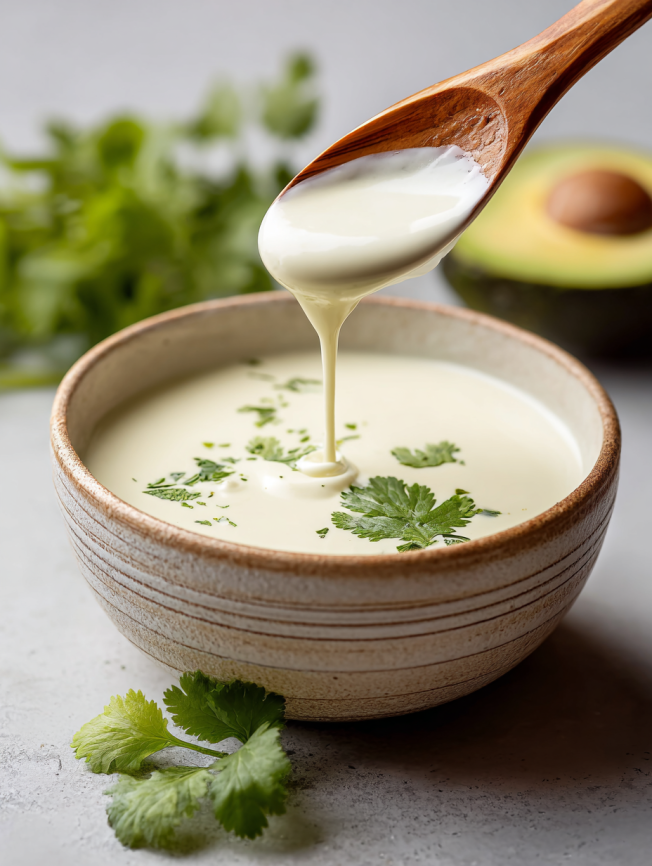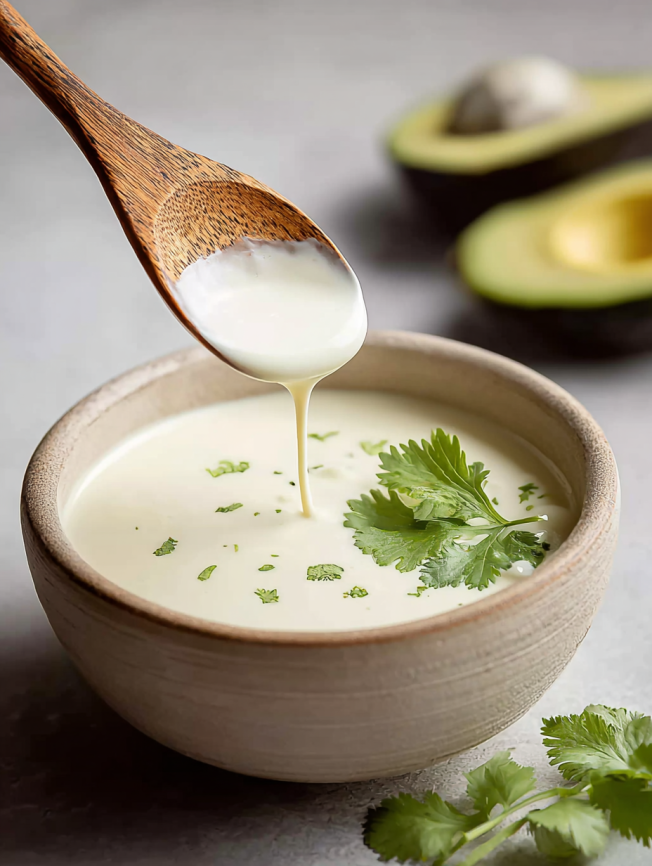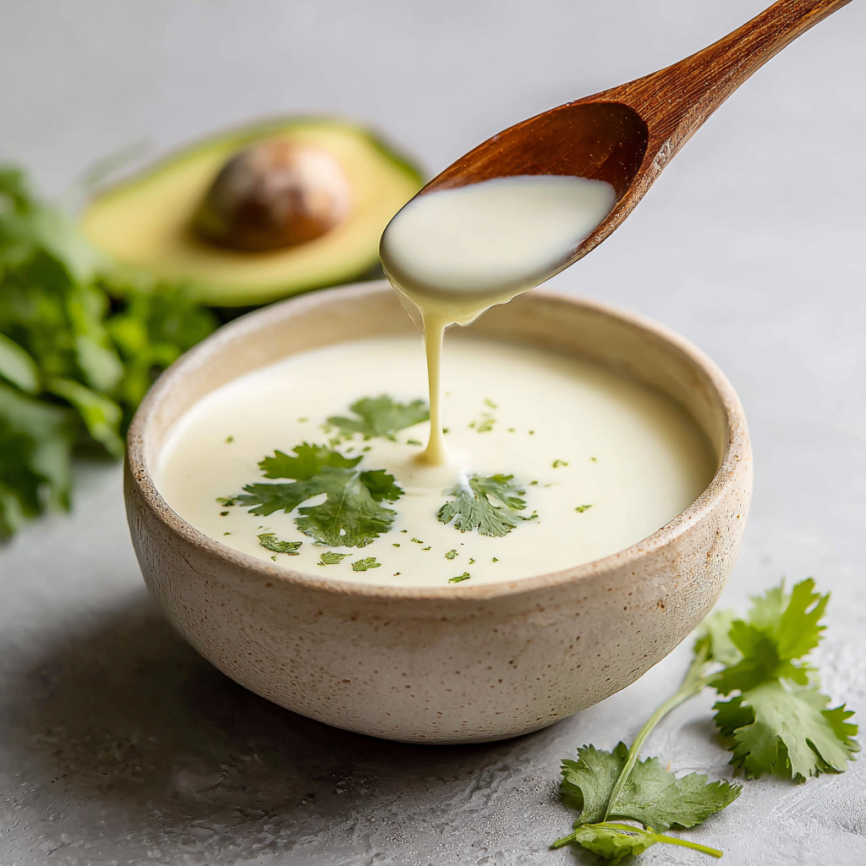My abuela never bought store-bought crema – she’d shake her head and mutter something about “why buy what you can make better at home?” This traditional Mexican cream sauce was always sitting in a glass jar on her kitchen counter, slowly developing that perfect tangy richness that only time and patience can create. The gentle fermentation process transforms simple ingredients into liquid gold that elevates every dish it touches.
What amazed me most as a child was how something so elegant could emerge from just a few basic ingredients left to work their magic. Now, decades later, I understand that the real secret wasn’t just in the recipe – it was in the love and tradition that guided every step of the process.
Why You’ll Love This Recipe
This authentic crema fresca offers a luxurious, silky texture that’s impossible to replicate with store-bought alternatives. The natural fermentation process creates complex flavors that dance between creamy richness and bright acidity, making it the perfect complement to spicy Mexican dishes.
Unlike heavy sour cream that can overwhelm delicate flavors, this traditional cream sauce enhances without masking. Furthermore, its incredible versatility means you’ll find yourself reaching for it again and again, whether you’re finishing a simple quesadilla or adding elegance to elaborate enchiladas.
The beauty of this recipe lies in its simplicity and forgiving nature. Even beginners can achieve professional results with minimal effort, while experienced cooks appreciate how this foundational sauce elevates their entire Mexican cooking repertoire.
Ingredients You’ll Need
Main Components
- 1 cup heavy cream (preferably not ultra-pasteurized)
- 2 tablespoons buttermilk (with active cultures)
- 2 tablespoons fresh lime juice
- 1/8 teaspoon fine salt
Quality Considerations
Choose heavy cream with the highest fat content available, as this creates the richest, most stable final product. Additionally, ensure your buttermilk contains live cultures – check the label for “active cultures” or “live cultures” for optimal fermentation results.
Fresh lime juice makes a noticeable difference compared to bottled alternatives. The natural oils in fresh lime zest can also be incorporated for enhanced citrus notes, though this is optional.
Essential Equipment
- Glass jar with lid or mixing bowl
- Clean kitchen towel or plastic wrap
- Fine-mesh strainer (optional)
- Small whisk or spoon for mixing

Step-by-Step Instructions
Creating the Culture Base
Begin by combining the heavy cream and buttermilk in your glass jar or bowl, whisking gently until they’re completely integrated. The buttermilk introduces beneficial bacteria that will transform the cream during fermentation.
Ensure all utensils and containers are thoroughly clean to prevent unwanted bacteria from interfering with the fermentation process. However, avoid using antibacterial soaps, as residue can inhibit the desired bacterial activity.
Fermentation Process
Cover your mixture with a clean kitchen towel or loose-fitting lid – the goal is to protect it from dust while allowing the fermentation gases to escape naturally. Never seal it tightly, as pressure buildup can affect the final texture and flavor.
Place the covered mixture in a warm location, ideally between 70-80°F (21-27°C). Popular spots include the top of the refrigerator, near a sunny window, or inside an oven with just the pilot light on. The warmth encourages active fermentation without overheating the delicate proteins.
Monitoring Development
Allow the mixture to culture for 12 to 24 hours, checking occasionally for thickness and aroma development. After 12 hours, you’ll notice it beginning to thicken slightly and develop a pleasant, tangy scent similar to buttermilk but richer.
The longer fermentation time creates more pronounced flavors, but don’t exceed 24 hours at room temperature. If your kitchen is particularly warm, check after 8-10 hours to prevent over-fermentation.
Final Seasoning
Once your cream has achieved the desired thickness and tanginess, stir in the lime juice and salt until perfectly blended. The acid from the lime juice will cause slight additional thickening, so incorporate it gradually while whisking.
Taste and adjust the lime and salt levels according to your preferences. Some families prefer more citrus brightness, while others enjoy a subtler lime presence that doesn’t compete with the dishes it accompanies.
Serving Suggestions
This versatile cream sauce enhances countless Mexican dishes with its rich, cooling properties. Drizzle it generously over street tacos, where it provides the perfect contrast to spicy meats and sharp onions.
Classic Applications: Transform simple black bean quesadillas into restaurant-quality meals, or finish pozole with an elegant swirl that balances the soup’s robust flavors.
Creative Uses: Try it as a base for salad dressings by thinning with additional lime juice, or use it as a luxurious dip for fresh vegetables and tortilla chips.
Breakfast Enhancement: A dollop on scrambled eggs or chilaquiles adds richness that elevates morning meals from ordinary to extraordinary.
Recipe Variations
Spiced Version
Incorporate 1/4 teaspoon of mild chili powder or a pinch of cayenne during the final seasoning stage for those who enjoy subtle heat. This variation pairs particularly well with grilled meats and vegetables.
Herb-Infused Crema
Stir in finely chopped cilantro, chives, or Mexican oregano after fermentation for an herbaceous twist that’s perfect for seafood dishes and vegetable preparations.
Smoky Chipotle Variation
Add a small amount of chipotle pepper in adobo sauce (start with 1/4 teaspoon) for a smoky, complex flavor that transforms ordinary dishes into memorable experiences.
Lighter Alternative
For a slightly less rich version, substitute half the heavy cream with whole milk. This creates a thinner consistency that works beautifully as a sauce rather than a dolloping cream.
Make-Ahead Tips
This traditional cream sauce actually improves with time, making it perfect for advance preparation. Once fermented and seasoned, it will keep in the refrigerator for up to two weeks when stored in a clean, airtight container.
For optimal freshness, always use clean utensils when portioning the cream to prevent contamination. Consider dividing larger batches into smaller containers to minimize exposure to air each time you use it.
The flavor continues developing even under refrigeration, though much more slowly. Many families find that day-three crema has the most balanced flavor profile, with the fermentation notes perfectly harmonized with the lime brightness.
Notes
Temperature Sensitivity: Avoid placing the fermenting cream in areas with temperature fluctuations, as this can create uneven fermentation and affect the final texture.
Visual Cues: Properly fermented cream will have a slightly thickened consistency and small bubbles around the edges. If you notice any unusual colors or off odors, discard the batch and start fresh.
Storage Guidelines: Always refrigerate the finished cream sauce. The cold temperature slows fermentation to a crawl while preserving the perfect flavor balance you’ve achieved.

Frequently Asked Questions
Q: Can I use ultra-pasteurized cream for this recipe? A: While possible, ultra-pasteurized cream doesn’t ferment as reliably due to the high-heat treatment that affects the protein structure. Regular pasteurized heavy cream produces consistently better results.
Q: What should I do if my cream doesn’t thicken after 24 hours? A: This usually indicates inactive cultures in your buttermilk or too-cool temperatures. Try moving it to a warmer location or starting over with fresh buttermilk that clearly states “live cultures” on the package.
Q: Is it safe to leave dairy products at room temperature for so long? A: Yes, the fermentation process creates an acidic environment that naturally preserves the cream. However, always trust your senses – if anything smells or looks off, discard it immediately.
Q: Can I speed up the fermentation process? A: While you can place it in a slightly warmer location (around 80°F), avoid rushing the process too much. The slow fermentation creates the complex flavors that make this cream sauce special.
Q: How do I know when it’s perfectly fermented? A: Look for a consistency similar to thick buttermilk with a pleasant, tangy aroma. It should coat a spoon lightly and have a clean, slightly acidic taste without any bitter or off flavors.
Preparation Time: 5 minutes | Culturing Time: 12-24 hours | Total Time: 12-24 hours Yields 1 cup (8 servings) | Skill Level: Beginner-Friendly | Cuisine: Mexican Dietary Notes: Low-Carb, Vegetarian, Gluten-Free

